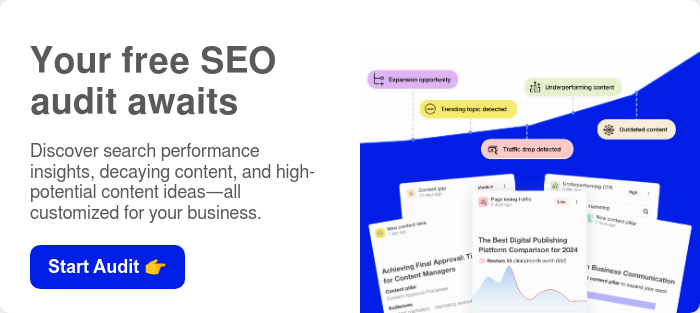When was the last time you ran a website traffic loss audit? If your content is under-optimized, you could be losing traffic—and with it, potential leads and revenue. Unoptimized content doesn’t just lower your rankings; it reduces your website’s visibility and drastically limits your traffic potential. In a digital-first world where search engine optimization (SEO) drives growth, under-optimized content can be a silent killer of your business objectives.
In this article, we’ll explore how under-optimized content leads to website traffic loss, and how you can use content audit tools to recover lost ground.
Why Content Optimization Matters for Traffic
For content agencies working in the B2B space, ensuring your clients' content is well-optimized for search engines is critical. SEO (Search Engine Optimization) isn’t just about inserting keywords; it’s about providing valuable content that ranks well in search engine results pages (SERPs) while delivering on user intent.
A study by Ahrefs found that 90.63% of all web pages get zero organic traffic from Google, primarily because these pages are not optimized properly. This statistic underscores the point that under-optimized content is virtually invisible. If search engines can’t find your content, neither can your potential audience.
A well-executed website traffic loss audit can reveal where your content is falling short and why your site isn’t receiving the traffic it should. Most often, the reasons include outdated information, poor keyword targeting, and technical SEO failures—all of which reduce your visibility on search engine results pages (SERPs).
📚 “Content Refresh: How + When to Refresh Existing Content”
How Under-Optimized Content Leads to Traffic Loss
1. Low search engine rankings
Search engines prioritize content that answers user queries accurately and in-depth. If your content lacks structure, relevant keywords, and authoritative backlinks, it won’t rank on the first page of search results—where 75% of users never venture beyond. Low rankings mean fewer clicks and a direct loss of website traffic. For example, pages that rank lower than the top 5 search results receive less than 5% of organic clicks, resulting in substantial traffic loss.
2. Outdated information
Search engines reward fresh, relevant content. If your blog posts or landing pages are outdated, they likely won't rank as high as newer content from competitors. Content stagnation can cause your SERP rankings to drop, leading to a steep decline in website traffic. As a result, old, unoptimized articles become invisible to new visitors, leaving you with a growing traffic gap.
3. Keyword mismatch
Without proper keyword research and targeting, your content may miss critical opportunities to capture valuable organic traffic. Unoptimized content often includes keyword mismatches or fails to target high-volume search queries, resulting in missed ranking opportunities. Conducting a website traffic loss audit can help pinpoint these gaps and correct them.
4. Lack of technical SEO
Factors like slow page load times, poor mobile usability, and missing metadata can also play a significant role in whether your content gets seen. The longer your pages take to load, the more traffic you lose. Even if your content is high-quality, poor technical SEO could result in substantial traffic loss.
Detect content decay early on and know exactly how to boost your rankings. Try StoryChief for free.
How Much Traffic Could You Be Losing?
The actual traffic loss due to under-optimized content varies, but it’s significant. Here’s how you can quantify the impact:
Rankings and Organic Search Traffic
A website ranking at the top of search results can capture nearly 33% of search traffic, while the second and third positions receive about 15% and 10%, respectively. If your content is under-optimized and buried on the second or third page of search results, you could be losing 98% of potential traffic.
CTR Decline
Click-through rates (CTR) drop dramatically as you fall in search rankings. With low CTR comes reduced engagement, fewer conversions, and ultimately, lost revenue.
Competitor Gains
When your content fails to rank, your competitors benefit. Every time you lose traffic due to under-optimized content, your competitors—who likely have better-optimized content—gain those visitors. In effect, your traffic loss becomes their traffic gain.
The Solution: How StoryChief's Content Audit Helps Recover Lost Traffic
StoryChief’s Content Audit tool is designed to help you identify and fix under-optimized content before it costs you more in lost traffic and conversions.
StoryChief’s Content Audit suggests 6 types of opportunities:
- New content ideas
- Page losing traffic
- Underperforming CTR
- Content gap
- Content expansion
- New content pillar

Here’s how it works:
1. Identify Low-Performing Content
The Content Audit feature from StoryChief allows you to audit existing pieces on your website to see which pages aren’t performing as they should. It identifies key weaknesses like missing metadata, and suboptimal keyword usage.
2. Pinpoint SEO Gaps
The audit will provide insights into where your content is missing the mark on essential SEO factors, such as keyword density, competitor keywords, and internal linking opportunities. It will highlight which pages need updates to improve search engine rankings.
3. Content Update Recommendations
StoryChief’s audit tool not only identifies problems but also provides actionable recommendations to refresh outdated content. Whether it's uncovering internal linking opportunities, or reworking keywords, these improvements will significantly boost your content’s SEO and engagement potential.
4. Track Performance Over Time
The tool also enables you to track content performance over time, allowing you to see the impact of your updates. This ongoing monitoring ensures that you’re continuously improving and adjusting your content to meet evolving SEO requirements and audience needs.
Don’t Let Unoptimized Content Drain Your Traffic
Unoptimized content doesn’t just impact your SEO rankings—it affects your overall business performance. If your content isn't driving traffic, it’s costing you leads, conversions, and ultimately, revenue. For B2B marketing teams, this is a critical issue that can’t be ignored.
With StoryChief’s Content Audit, you can identify underperforming content, fix optimization issues, and recover lost traffic.
Stop letting unoptimized content hurt your traffic potential. Conduct a comprehensive content audit today.









